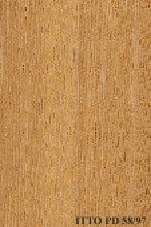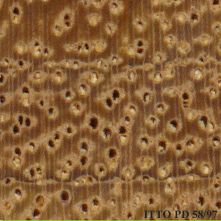
DABEMA (Piptadeniastrum africanum)
Trade Name
Dabema
Scientific Name
Piptadeniastrum africanum Brenan
Family
LEGUMINOSAE
Common Names
Mbele (Sierra Leone); Guli (Sierra Leone); Beyae (Guinea); Odan (Ghana); Elae (Ghana); Dabema (Côte d`Ivoire); Odan (United Kingdom); Elae (United Kingdom); Ekhimi (United Kingdom); Agboin (United Kingdom); N'singa (Congo); Koungou (Central African Republic); N'singa (Angola); Wunga; To; Singa; Sanga; Redwood; Odanwoma; Odannan; Odane; Odan; Nga; N-go; Mussasae; Musese; Mugeye; Mbele-guli; Koungou; Ka-bari; K-kuperb; Jondo; Itoumb?; Gau; Erundu; Eran; Elany; Elae; Ekhivi; Dubima; Dane; Dandad; Chen; Bokungo; Bokundu; Bi-eh; Banzu; Akasanumu; Agbion; African greenheart; Bokungu (Zaire); N`inga (Angola); N`singa (Congo); Toum (Gabon); Tom (Equatorial Guinea); Atui (Cameroon); Mbeli (Liberia); Ekhimi (Nigeria); Agboin (Nigeria); Dahoma (Ghana); Debema (Côte d`Ivoire); Bukundu (Netherlands); Ekhim (United Kingdom); Dahoma (United Kingdom); Mpewere (Uganda); Likundu (Zaire); Dabema
Scientific Name Synonyms
Piptadenia africana Hook. f.
Description Of The Tree
Botanical Description
The tree reaches a height of 26 to 32 m, with trunk diameters up to 130 cm. The bole is cylindrical, straight, and slightly buttressed.
Natural Habitat
Piptadeniastrum africanum is found in rain forest and transitional formations, often as a solitary emergent tree in farmland and secondary bush.
Natural Distribution
West, Central and East Africa, from Senegal to Angola and Uganda.
Wood Identification
Anatomic Description Of Wood
Wood diffuse porous. Occasionally vessels exclusively solitary (over 90%). Tangential diameter of vessel lumina 200 micras or more (large). Vestured pits. Vessels per mm2 less than 6 (rare). Simple perforation plates. Vessel-ray pits similar to intervessel pits Axial parenchyma lozenge-aliform. Prismatic crystals in chambered axial parenchyma cells and/or in fibers. 5 to 8 cells per parenchyma strand. 4 to 10 rays per mm (medium). Rays non-storied. Larger rays more than 4 seriate. Homogeneous rays and/or sub-homogeneous rays (all ray cells procumbent). Body ray cells procumbent with one row of upright and/or square marginal cells (Kribs-III). Occasionally septate fibers present. Fibers with simple to minutely bordered pits.
-
 Wood Macro Photo Tangential Plane
Wood Macro Photo Tangential Plane
-
 Wood Micro Photo Of Transversal Section
Wood Micro Photo Of Transversal Section
Availability
Cites Status
Unrestricted
General Wood Description
Odor
Unpleasant odor of ammoniac.
Color
The sapwood is light color, it has a thickness of 5 or more cm. The heartwood is light brown to yellow-brown, it is clearly demarcated. The silver figure is fine (barely visible).
COLOR INDEX (1=Black, 7=Light yellow,white)
5
Grain
The grain is highly and systematically interlocked; special care is needed when drying because of frequent risks of distortion.
Texture
This wood has a somewhat coarse texture.
Luster
This wood is frequently low in luster.
Natural Durability
Moderately durable to decay. Without preservative treatment, this species can be used only under risk of occasional re-humidification. It is not suited for uses with risks of permanent or long-lasting humidification. Resistant to termites attack. The hear
Natural durability index (1= Very high durability, 7=Vey low durability)
3
Internal Growth Stresses
This species is reported to have growth stresses.
Silica Content
Silica Content: Negligible content of silica is reported. Amounts over 0.05% may affect wood processing. Silica Value: 0
Resistance To Impregnation
Difficult to treat with only a low penetration of the preservative products.
Wood Physical Properties
Basic Density or Specific Gravity (O.D. weight/vol. green) (g/cm³)
0.63
Air-dry Density (Weight and volume at 12%MC) (g/cm³)
0.70
Total shrinkage Tangential (Saturated to 0%MC) (%)
8.5
Total shrinkage Radial (Saturated to 0%MC) (%)
3.8
Drying Defects
Ease of Drying: Drying is moderately easy; some particular care is needed. Drying Defects: Risks of casehardening and checks Kiln Schedules: Schedule proposed as a reference by comparison with well known species taking into account to the general technological behavior of this species.
Recommended Dry Kiln Schedule
FR-13
Dimensional stability ratio (Total Tangential Shrinkage %/Total Radial Shrinkage %)
2.2
Wood Chemical Properties
Wood Mechanical Properties
Bending Strength (MOR),12%MC (kgf/cm²)
994
Stiffness (MOE) 12%MC (kgf/cm²)
154862
Compression parallel to fiber 12%MC (kgf/cm²)
583
Compression perpendicular to fiber 12%MC (kgf/cm²)
76
Shear strength radial 12%MC (kgf/cm²)
106
Janka hardness (side) 12%MC (kgf)
611
Janka hardness (end grain) 12%MC (kgf)
707
Workability
Sawing
It is moderately easy to saw.
Rotary Veneer Cutting
Not suitable for veneering.
Sliced Veneer
Not suitable for veneering.
Blunting Effect
Slight blunting effect; ordinary tools can be used for sawing and machining.
Machining
Possible difficulties caused by interlocked grain are reported.
Planing
Moderately easy; tools must be cautiously sharpened.
Moulding
Moderately easy; tools must be cautiously sharpened.
Boring
Moderately easy; tools must be cautiously sharpened.
Mortising
Moderately easy; tools must be cautiously sharpened.
Nailing
Pre-boring is necessary.
Gluing
Glues well if basic gluing technical rules are followed.
Sanding
Difficult to obtain very good results because of interlocked grain.
Polishing
Needs pre-coating.
Steam Bending
This species can be used for steam bending.
Response To Hand Tools
No particular problems.
REFERENCED USES
End Uses Summary
EXTERIOR GENERAL, rails, HOUSING GENERAL, beams, joists, boards, flooring, parquet, frames, steps, FURNITURE AND CABINETS, common furniture, CONTAINERS, truck bodies, truck flooring
Exterior General
- 1 - Tabela de resultados de ensaios fisicos e mecanicos
Rails
- 6 - Physical and mechanical properties of Eucalyptus deglupta Blume grown in Costa Rica
General Housing
- 10 - Silica in Timbers
Beams
- 11 - Prospect: The wood database
Joists
- 12 - Tropical timbers of the world. Part I-Tropical American Species
Boards
- 13 - Dry kiln schedules for commercial woods. Temperate and tropical. Section III. Latin American (Mexico, Central, and South America) Woods–Conventional Temperatures
Flooring
- 14 - Handbook of Hardwoods
Parquet
- 15 - Empire Timbers
Frames
- 16 - Woods of the World
Steps
- 17 - Tree Conservation Database
Furniture Cabinets
- 21 - Tropical timbers of the world. Part III-Southeast Asian and Oceanian Species.
Furniture, Common
- 23 - Handbook of Hardwoods
Truck Body
- 53 - Timbers of the New World
Truck Flooring
- 54 - Bulletin of the Government Forest Experiment Station N.157: Identification of Tropical Woods
Please Provide Information To View Producer Information